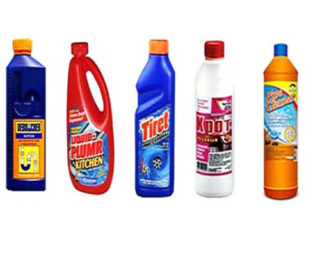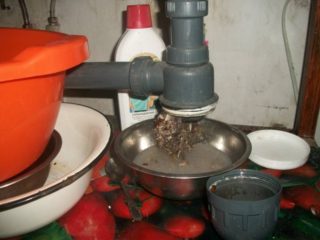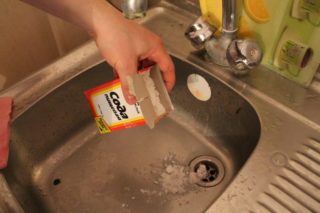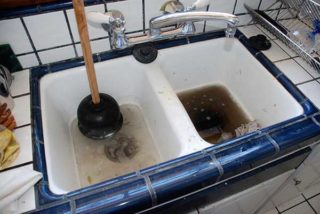Fat deposits in pipes (regardless of the material of manufacture) are a serious problem that every owner of a living room faces. It is important to resolve the issue of cleaning in a timely manner in order to prevent violations of the correct operation of the sewer system. In this case, it is not necessary to resort to the help of a plumber; you can cope with blockages on your own. There are many simple options for cleaning the plumbing, for the implementation of which you only need cleaning agents, an improvised tool and a little free time.
Why does fat settle on pipes
A large amount of fat remains and settles in the water supply system and sewage system, turning into a sticky film, which lines the pipes from the inside layer by layer. Over time, threads, hair, and other small debris adhere to it and a dense cork forms through which a full-fledged drain cannot be made. An unpleasant odor is a sure sign of a blockage.
Often this problem appears if cast iron sewer pipes are installed in a house or apartment. The rough structure of the metal promotes adhesion of fatty deposits to it. If we talk about modern polypropylene and PVC pipes, then blockages in them are formed due to deformation of the material during its long-term operation.
A favorable condition for the accumulation of fat is:
- washing dishes in cold water;
- draining cooled soup or broth into the sewer;
- washing pans and pots without the use of special products;
- improperly installed sewerage / water supply.
To avoid accumulation of fat, preventive measures must be taken periodically. If the blockage still occurs, you can eliminate it yourself using simple methods and available tools.
Dissolving fat with chemicals
- Loose (in the form of powder or granules) - packed in plastic bags with special protection and used for 1 cleaning. They contain potent substances, therefore, when used, they require compliance with safety measures.
- Liquid or gel - available in plastic containers. The main active ingredient is alkali, and components for bleaching and eliminating unpleasant odors are also included.
Among the many brands, the most effective and popular are distinguished:
- Mister Muscle;
- Mole;
- Sanox;
- Selena;
- Deboucher;
- Chirton;
- Pothan.
Chemicals are easy to use. You need to shake the bottle (in the case of a liquid form), pour or pour the contents into the drain hole and leave for 2 hours, and then rinse with plenty of warm water. The use of chemicals requires protective equipment (rubber gloves, respirator). If the funds come into contact with the skin, rinse them off quickly with water.
Mechanical cleaning methods
- Cover the drain hole with a plunger.
- Fill the sink with water to a level above the rubber valve on the fixture.
- Perform several movements of the plunger without lifting it off the surface.
If the blockage is too deep and blocks the water flow almost completely, use a plumbing cable with tips in the form of a volume spring or a metal brush. Dealing with it is not as difficult as it seems:
- Unscrew the drain and siphon.
- Insert the free end of the cable into the pipe, twisting it in a circular motion.
- When you reach the grease plug, using maximum force, twist the cable until it passes freely through the pipe. At the same time, from time to time, serve hot water into the sink so that the pieces of cork go down the drain.
- Pull the cable out of the pipe, clean it and lubricate it with machine oil.
- Flush the pipe through the drain with plenty of water.
You can also remove grease deposits from the pipe using a hydrodynamic method using a compressor that is capable of generating a pressure of 190 MPa (these compact devices are easy to find on the market). The method is effective for use in the most inaccessible places. In the process of work, it is necessary to insert the hose nozzle into the pipe to a depth of 50-60 cm and connect the compressor. The system will work automatically, moving gradually further and further along the water supply thanks to the jet thrust. The nozzle is chosen depending on the severity of the blockage (universal, punching, chain-carousel).
If you cannot cope with the problem on your own, call specialists who have professional equipment. Thanks to thermochemical and pneumohydro-impulse cleaning, they will eliminate the problem in the shortest possible time.
Folk remedies
Procedure:
- Pour 0.5 cups of baking soda into the drain.
- Pour in 1 cup of vinegar or citric acid solution (25 g per 250 ml of hot water).
- Close the drain plug for 20 minutes.
- Drain a large amount of hot water from the tap into the system.
For cleaning iron and cast iron pipes, it is better to use a more gentle method to avoid destruction of the inner protective layer and prevent metal corrosion. For this:
- Pour 1 cup of baking soda into the drain.
- Pour 1 liter of hot water and close the hole with a stopper for 15-20 minutes.
- Flush the system with hot water.
You can use chlorine bleach or toilet cleaner to clean both iron and plastic pipes. It is necessary:
- Pour 1 liter of product into the system and leave for an hour.
- Flush the pipes with plenty of water.
Prophylaxis
- Do not save on water with excessive fanaticism. If the required amount of liquid does not enter the pipes, they will not be naturally cleaned. The sewage system especially needs hot water, which breaks down fat well.
- Don't use the toilet as a trash can. Even toilet paper is not recommended to be thrown in there, not to mention draining fat from pans, soup and broth. The best solution is to collect them in a container and throw them away with the trash.
- Place the nets on the kitchen sink and on the drain in the bathroom.This will prevent food debris from entering the hair pipes, which will not adhere to the sticky layer of fat and will not form a plug.
- Every six months, clean the drain system with soda, boiling water and vinegar. It is fast, safe and very effective.
- Do not entrust the work of installing sewerage and water supply to dubious plumbers.
- Remember that pipes have their own service life. Its significant excess can damage the entire sewer system.
Owners of private houses are advised to constantly monitor the water level in the sewer wells so that their contents do not escape through the drain holes in the kitchen and in the bathrooms. This is especially dangerous if the system is not equipped with a check valve on the outlet pipe.
Remember that blockages always occur unexpectedly and create serious discomfort for those living in an apartment or private house. To ensure long-term and uninterrupted operation of the water supply and sewerage system, it is necessary to provide the pipes with proper and timely maintenance, as well as put protective equipment on the drain holes.













